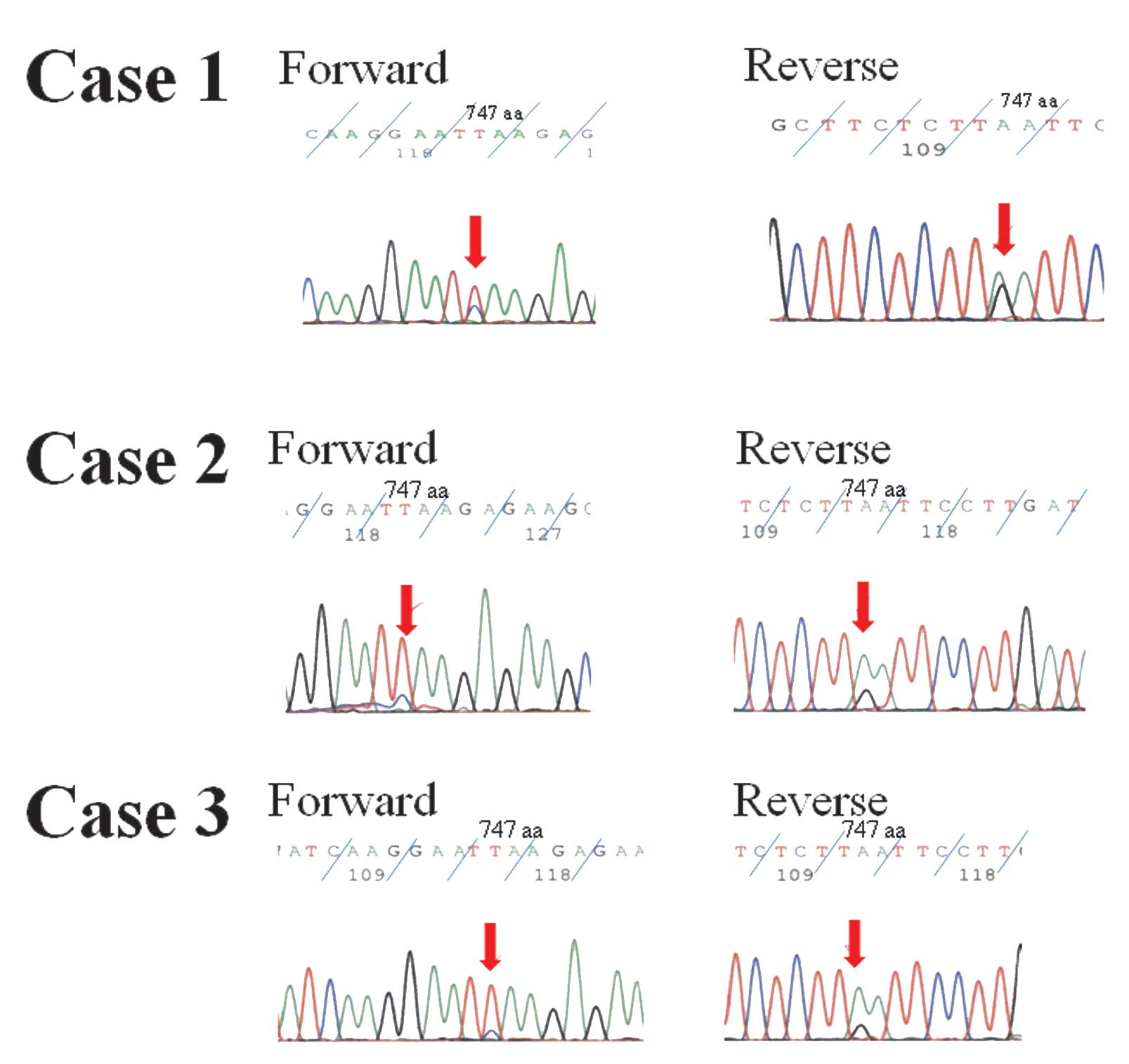|
1
|
Maemondo M, Inoue A, Kobayashi K, Sugawara
S, Oizumi S, et al: Gefitinib or chemotherapy for non-small-cell
lung cancer with mutated EGFR. N Engl J Med. 362:2380–2388. 2010.
View Article : Google Scholar : PubMed/NCBI
|
|
2
|
Mitsudomi T, Morita S, Yatabe Y, Negoro S,
Okamoto I, et al: Gefitinib versus cisplatin plus docetaxel in
patients with non-small-cell lung cancer harbouring mutations of
the epidermal growth factor receptor (WJTOG3405): an open label,
randomised phase 3 trial. Lancet Oncol. 11:121–128. 2010.
View Article : Google Scholar
|
|
3
|
Zhou C, Wu YL, Chen G, Feng J, Liu XQ, et
al: Erlotinib versus chemotherapy as first-line treatment for
patients with advanced EGFR mutation-positive non-small-cell lung
cancer (OPTIMAL, CTONG-0802): a multicentre, open-label,
randomised, phase 3 study. Lancet Oncol. 12:735–742. 2011.
View Article : Google Scholar
|
|
4
|
Rosell R, Carcereny E, Gervais R,
Vergnenegre A, Massuti B, et al: Erlotinib versus standard
chemotherapy as first-line treatment for European patients with
advanced EGFR mutation-positive non-small-cell lung cancer
(EURTAC): a multicentre, open-label, randomised phase 3 trial.
Lancet Oncol. 13:239–246. 2012. View Article : Google Scholar
|
|
5
|
Pao W and Girard N: New driver mutations
in non-small-cell lung cancer. Lancet Oncol. 12:175–180. 2011.
View Article : Google Scholar : PubMed/NCBI
|
|
6
|
Mitsudomi T and Yatabe Y: Mutations of the
epidermal growth factor receptor gene and related genes as
determinants of epidermal growth factor receptor tyrosine kinase
inhibitors sensitivity in lung cancer. Cancer Sci. 98:1817–1824.
2007. View Article : Google Scholar
|
|
7
|
Tanaka T, Matsuoka M, Sutani A, Gemma A,
Maemondo M, et al: Frequency of and variables associated with the
EGFR mutation and its subtypes. Int J Cancer. 126:651–655. 2010.
View Article : Google Scholar : PubMed/NCBI
|
|
8
|
Lin L and Bivona TG: Mechanisms of
resistance to epidermal growth factor receptor inhibitors and novel
therapeutic strategies to overcome resistance in NSCLC patients.
Chemother Res Pract. 2012:8172972012.
|
|
9
|
Suda K, Mizuuchi H, Maehara Y and
Mitsudomi T: Acquired resistance mechanisms to tyrosine kinase
inhibitors in lung cancer with activating epidermal growth factor
receptor mutation-diversity, ductility, and destiny. Cancer
Metastasis Rev. 31:807–814. 2012. View Article : Google Scholar
|
|
10
|
Yamaguchi F, Kugawa S, Tateno H, Kokubu F
and Fukuchi K: Analysis of EGFR, KRAS and P53 mutations in lung
cancer using cells in the curette lavage fluid obtained by
bronchoscopy. Lung Cancer. 78:201–206. 2012. View Article : Google Scholar : PubMed/NCBI
|
|
11
|
Pallis AG, Voutsina A, Kalikaki A,
Souqlakos J, Briasoulis E, et al: ‘Classical’ but not ‘other’
mutations of EGFR kinase domain are associated with clinical
outcome in gefitinib-treated patients with non-small cell lung
cancer. Br J Cancer. 97:1560–1566. 2007.
|
|
12
|
Jia XL and Chen G: EGFR and KRAS mutations
in Chinese patients with adenosquamous carcinoma of the lung. Lung
Cancer. 74:396–400. 2011. View Article : Google Scholar : PubMed/NCBI
|
|
13
|
Costa DB, Schumer ST, Tenen DG and
Kobayashi S: Differential responses to erlotinib in epidermal
growth factor receptor (EGFR)-mutated lung cancers with acquired
resistance to gefitinib carrying the L747S or T790M secondary
mutations. J Clin Oncol. 26:1182–1184. 2008. View Article : Google Scholar
|
|
14
|
Costa DB, Nguyen KS, Cho BC, Sequist LV,
Jackman DM, et al: Effects of erlotinib in EGFR mutated non-small
cell lung cancers with resistance to gefitinib. Clin Cancer Res.
14:7060–7067. 2008. View Article : Google Scholar : PubMed/NCBI
|
|
15
|
Goto K, Satouchi M, Ishii G, Nishio K,
Hagiwara K, et al: An evaluation study of EGFR mutation tests
utilized for non-small-cell lung cancer in the diagnostic setting.
Ann Oncol. 23:2914–2919. 2012. View Article : Google Scholar
|
|
16
|
Fukui T, Tsuta K, Furuta K, Watanabe S,
Asamura H, et al: Epidermal growth factor receptor mutation status
and clinicopathological features of combined small cell carcinoma
with adenocarcinoma of the lung. Cancer Sci. 98:1714–1719. 2007.
View Article : Google Scholar : PubMed/NCBI
|
|
17
|
Morinaga R, Okamoto I, Furuta K, Kawano Y,
Sekijima M, et al: Sequential occurrence of non-small cell and
small cell lung cancer with the same EGFR mutation. Lung Cancer.
58:411–413. 2007. View Article : Google Scholar : PubMed/NCBI
|
|
18
|
Tatematsu A, Shimizu J, Murakami Y, Horio
Y, Nakamura S, et al: Epidermal growth factor receptor mutations in
small cell lung cancer. Clin Cancer Res. 14:6092–6096. 2008.
View Article : Google Scholar : PubMed/NCBI
|
|
19
|
Zakowski MF, Ladanyi M and Kris MG;
Memorial Sloan-Kettering Cancer Center Lung Cancer OncoGenome
Group. EGFR mutations in small-cell lung cancers in patients who
have never smoked. N Engl J Med. 355:213–215. 2006. View Article : Google Scholar : PubMed/NCBI
|
|
20
|
Okamoto I, Araki J, Suto R, Shimada M,
Nakagawa K and Fukuoka M: EGFR mutation in gefitinib-responsive
small-cell lung cancer. Ann Oncol. 17:1028–1029. 2006. View Article : Google Scholar : PubMed/NCBI
|
|
21
|
Lu HY, Mao WM, Cheng QY, Chen B, Cai JF,
et al: Mutation status of epidermal growth factor receptor and
clinical features of patients with combined small cell lung cancer
who received surgical treatment. Oncol Lett. 3:1288–1292. 2012.
|
|
22
|
Sequist LV, Waltman BA, Dias-Santagata D,
Digumarthy S, Turke AB, et al: Genotypic and histological evolution
of lung cancers acquiring resistance to EGFR inhibitors. Sci Transl
Med. 3:75ra262011. View Article : Google Scholar : PubMed/NCBI
|
|
23
|
Alam N, Gustafson KS, Ladanyi M, Zakowski
MF, Kapoor A, et al: Small-cell carcinoma with an epidermal growth
factor receptor mutation in a never-smoker with
gefitinib-responsive adenocarcinoma of the lung. Clin lung Cancer.
11:E1–E4. 2010. View Article : Google Scholar : PubMed/NCBI
|










